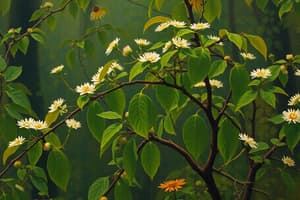Podcast
Questions and Answers
What is the scientific term for a living thing?
What is the scientific term for a living thing?
organism
All living things are?
All living things are?
organized
What is the simplest level at which life may exist?
What is the simplest level at which life may exist?
cell
Are all cells alike?
Are all cells alike?
All cells perform various jobs or?
All cells perform various jobs or?
What surrounds a cell and separates it from its environment?
What surrounds a cell and separates it from its environment?
What is the difference between unicellular and multicellular organisms?
What is the difference between unicellular and multicellular organisms?
Give an example of a multicellular organism.
Give an example of a multicellular organism.
Give an example of a unicellular organism.
Give an example of a unicellular organism.
Multicellular organisms can be organized into what other levels?
Multicellular organisms can be organized into what other levels?
Define reproduction.
Define reproduction.
Must every member of a particular species be able to reproduce in order for the species to survive?
Must every member of a particular species be able to reproduce in order for the species to survive?
What would happen if all individuals in a species were sterile?
What would happen if all individuals in a species were sterile?
Reproduction is NOT essential for the survival of an individual __________ but is essential for the survival of the __________.
Reproduction is NOT essential for the survival of an individual __________ but is essential for the survival of the __________.
What is meant by extinction?
What is meant by extinction?
Name and define the two basic kinds of reproduction.
Name and define the two basic kinds of reproduction.
Identify which of the following organisms reproduce sexually or asexually: Bacteria, Hydra, Sea Urchin.
Identify which of the following organisms reproduce sexually or asexually: Bacteria, Hydra, Sea Urchin.
How do all organisms begin life?
How do all organisms begin life?
What is the difference between growth and development?
What is the difference between growth and development?
Do unicellular organisms grow?
Do unicellular organisms grow?
Do unicellular organisms develop?
Do unicellular organisms develop?
Do multicellular organisms grow?
Do multicellular organisms grow?
Do multicellular organisms develop?
Do multicellular organisms develop?
How is the growth of a living thing different from the growth of a nonliving thing?
How is the growth of a living thing different from the growth of a nonliving thing?
Define energy.
Define energy.
Why is energy important to a living organism?
Why is energy important to a living organism?
What is the difference between an autotroph and a heterotroph?
What is the difference between an autotroph and a heterotroph?
What is the name of the process that plants use to make their own food using energy from the sun?
What is the name of the process that plants use to make their own food using energy from the sun?
What are some environmental factors that organisms respond to?
What are some environmental factors that organisms respond to?
Organisms must also respond to ___________ factors in order to stay healthy & survive.
Organisms must also respond to ___________ factors in order to stay healthy & survive.
What are two internal factors that organisms respond to?
What are two internal factors that organisms respond to?
Give two examples of how living things respond to changes in their environment.
Give two examples of how living things respond to changes in their environment.
If light is applied to a human eye, how does it respond?
If light is applied to a human eye, how does it respond?
Describe homeostasis.
Describe homeostasis.
Identify the feature of life illustrated by the statement 'That boy shot up five inches in only one year.'
Identify the feature of life illustrated by the statement 'That boy shot up five inches in only one year.'
Identify the feature of life illustrated by the statement 'Our cat had a litter of kittens yesterday.'
Identify the feature of life illustrated by the statement 'Our cat had a litter of kittens yesterday.'
Identify the feature of life illustrated by the statement 'My dog has become much less clumsy now that he is a year old.'
Identify the feature of life illustrated by the statement 'My dog has become much less clumsy now that he is a year old.'
Identify the feature of life illustrated by the statement 'Eat a good breakfast and you will be able to run longer.'
Identify the feature of life illustrated by the statement 'Eat a good breakfast and you will be able to run longer.'
Identify the feature of life illustrated by the statement 'When that car pulled in the driveway, my cat ran to hide under the porch.'
Identify the feature of life illustrated by the statement 'When that car pulled in the driveway, my cat ran to hide under the porch.'
Identify the feature of life illustrated by the statement 'That owl's night vision allows it to see the movement of mice on even the darkest night.'
Identify the feature of life illustrated by the statement 'That owl's night vision allows it to see the movement of mice on even the darkest night.'
Identify the feature of life illustrated by the statement 'Single-celled organisms live in the pond behind the school.'
Identify the feature of life illustrated by the statement 'Single-celled organisms live in the pond behind the school.'
Identify the feature of life illustrated by the statement 'Your body normally maintains a temperature of 98.6°F.'
Identify the feature of life illustrated by the statement 'Your body normally maintains a temperature of 98.6°F.'
Identify the feature of life illustrated by the statement 'A giraffe uses its long neck to eat from the high branches of a tree.'
Identify the feature of life illustrated by the statement 'A giraffe uses its long neck to eat from the high branches of a tree.'
Identify the feature of life illustrated by the statement 'is another name for
Identify the feature of life illustrated by the statement 'is another name for
Which of the following is a stimulus: the recess bell ringing in an elementary school?
Which of the following is a stimulus: the recess bell ringing in an elementary school?
Which of the following is a response: your mouth watering at the sight of food on a plate?
Which of the following is a response: your mouth watering at the sight of food on a plate?
Which of the following is a stimulus: a sudden drop in air temperature?
Which of the following is a stimulus: a sudden drop in air temperature?
Which of the following is a stimulus: a flu virus entering your body?
Which of the following is a stimulus: a flu virus entering your body?
Which of the following is a response: getting 'butterflies' in your stomach before giving a speech?
Which of the following is a response: getting 'butterflies' in your stomach before giving a speech?
Determine if the following describes a living or nonliving thing: rust eating a hole in a metal bucket.
Determine if the following describes a living or nonliving thing: rust eating a hole in a metal bucket.
Determine if the following describes a living or nonliving thing: an apple on a tree.
Determine if the following describes a living or nonliving thing: an apple on a tree.
Determine if the following describes a living or nonliving thing: bacteria.
Determine if the following describes a living or nonliving thing: bacteria.
Determine if the following describes a living or nonliving thing: lightning.
Determine if the following describes a living or nonliving thing: lightning.
Determine if the following describes a living or nonliving thing: a dinosaur fossil.
Determine if the following describes a living or nonliving thing: a dinosaur fossil.
Determine if the following describes a living or nonliving thing: a wasp.
Determine if the following describes a living or nonliving thing: a wasp.
List characteristics of all living things.
List characteristics of all living things.
Flashcards are hidden until you start studying
Study Notes
Characteristics of Life
- Organism: A scientific term for any living thing.
- Living Things: All living things are organized and composed of cells, which is the simplest level at which life may exist.
- Cell Types: Cells vary in structure and function; some organisms are unicellular (one cell), while others are multicellular (multiple cells).
Reproduction and Survival
- Reproduction Definition: The process of producing offspring to ensure species continuation.
- Species Continuation: Not every member of a species needs to reproduce; a few can sustain the species.
- Sterility Consequence: If all individuals of a species are sterile, the species would eventually face extinction.
- Extinction: Defined as the total death of a species.
Types of Reproduction
- Basic Types:
- Sexual Reproduction: Involves two parents and the combination of genetic material.
- Asexual Reproduction: Involves a single organism reproducing by itself.
Growth and Development
- Growth vs. Development: Growth is an increase in living material, while development refers to changes over a life span.
- Unicellular Growth: Unicellular organisms grow but do not develop in the same manner as multicellular organisms.
Energy and Nutrition
- Energy Definition: The capacity to perform work or induce change.
- Importance of Energy: Essential for powering life processes within an organism.
- Autotrophs vs. Heterotrophs:
- Autotrophs: Organisms that produce their food using sunlight (e.g., plants through photosynthesis).
- Heterotrophs: Organisms that obtain energy by consuming other organisms.
Homeostasis and Response to Stimuli
- Homeostasis: The ability of an organism to maintain a stable internal environment despite external changes.
- Responses to Stimuli: Organisms respond to environmental factors (e.g., light, temperature) and internal factors (e.g., hydration levels).
- Examples of Responses: Squinting in bright light or turning toward a sound.
Characteristics of Living Things
- Living Cells: All living things are composed of one or more cells.
- Reproduction: Essential for the survival of species.
- Energy Utilization: All living organisms use energy to carry out life processes.
- Growth and Development: Organisms grow and develop throughout their life cycles.
- Homeostasis: Maintaining stable internal conditions.
- Environmental Interaction: Living things respond to their environments.
Examples of Living and Nonliving Things
- Living: Bacteria, an apple on a tree, a wasp.
- Nonliving: Rust, lightning, dinosaur fossils.
Summary of Features of Life
- Organism: Another term for a living thing.
- Stimulus vs. Response: A stimulus provokes a response (e.g., a bell ringing is a stimulus, mouth watering at food sight is a response).
These key points highlight the fundamental characteristics and concepts related to life and living organisms.
Studying That Suits You
Use AI to generate personalized quizzes and flashcards to suit your learning preferences.




